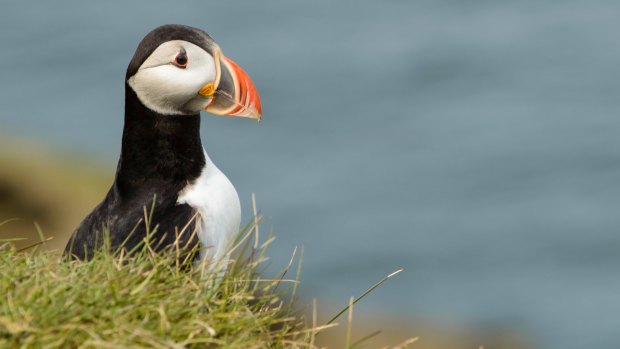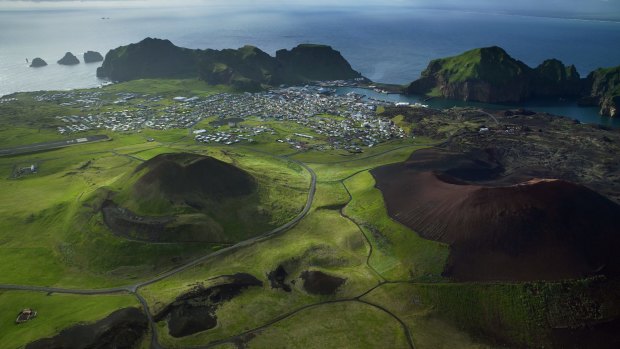This was published 4 years ago
Heimaey Island, Iceland: The astonishing island that was nearly torn apart by a volcano
By Brian Johnston

Puffin above the cliffs of Heimaey Island in south Iceland.Credit: iStock
Our expedition ship sails cautiously into Vestmannaeyjar harbour. On one side of its narrow dogleg opening, sheer cliffs are patrolled by seabirds. On the other side, North Atlantic waves surge against rough lava shelves. When the lava flowed, it threatened to cut off the harbour entrance, lifeline of this fishing-dependent island. Locals and rescue services sprayed the lava with water, managing to divert its progress. Livelihoods were saved, but half the town was engulfed.
"I was only 10 years old when it happened," says our local guide Toki, who meets us off our ship when we're safely docked. "I remember seeing the fire front. It was like the bonfires we light for the elves on New Year's Eve, so I wasn't scared. But my parents must have been terrified."
The residents of Heimaey Island were completely unaware they were living on top of a volcano, explains Toki as we venture into the lava fields. In the middle of the night on 23 January 1973, the fields outside Vestmannaeyjar simply split open. The town started to shake. Fissures 1600 metres long began spewing lava, and half a million cubic metres of ash engulfed buildings like snowdrift.

Volcanic craters, Vestmannaeyjar.Credit: Getty
The 5300 islanders clambered into their fishing boats and escaped to sea. They wouldn't be back until the eruption stopped five months later. By then Eldfell was a 220-metre volcano and a great chunk of island had been transformed. Four hundred homes were gone, swallowed by lava or crushed by ash.
"My house was built in 1911 and had a sloping roof, unlike many newer ones, so it didn't collapse under the weight of the ash," says Toki.
Today lupins grow out of Eldfell's ash and red gravel, which in places is still hot enough to cook eggs. From a lookout, we see that the town is half-encased in a carapace of ugly black pumice. Homeowners on Vastmannabrau Street can look out their back windows and see the wall of lava where once their neighbours looked back. Bits of wall stick up through the hillside like dinosaur bones. The four walls of one house remain. The interior is heaped with ash that spills out of its shattered windows.
Eldheimar museum preserves an even more striking ruin. The museum is built around a large home abandoned by a family of five on eruption night as they fled with nothing but a baby bottle and some clothes. It's a time capsule of the 1970s, hung with half-burnt curtains and filled with charred roof beams and upturned tables. Multimedia exhibits tell the compelling tale of the night the volcano erupted, and its aftermath. Residents speak from recordings and appear in jerky film footage showing the rescue efforts.
Toki knows almost all of them, because most residents returned to Heimaey Island. The town has regrown right beside the half that was gobbled up by lava. The volcano slumbers, but still defines life here.
"We talk of before the eruption and after the eruption on the island, it's how we keep time," says Toki. "Are we nervous? No. We're well prepared."
Heimaey Island has a savage beauty. Its green mist-shrouded cliffs and jagged skerries are home to eight million puffins. Sheep are tilted on plunging hillsides. Vestmannaeyjar, the only town, has a couple of fish-processing plants, a few cafes, a Cantonese restaurant, a beautiful wooden chapel.
It's the quintessential expedition-cruise destination, small but extraordinary, and rather haunting. As our ship sails away, the last we see of Heimaey is a wave-pounded lava coast, and lonely cliffs where seabirds shriek.
TRIP NOTES
Brian Johnston was as a guest of Abercrombie & Kent.
Abercrombie & Kent's 15-day In Search of the Polar Bear cruise departs 31 July 2020 and visits Svalbard, Greenland and Iceland. Prices from $21,720 a person including meals, drinks, gratuities, airport transfers and daily excursions. See abercrombiekent.com.au
Sign up for the Traveller Deals newsletter
Get exclusive travel deals delivered straight to your inbox. Sign up now.